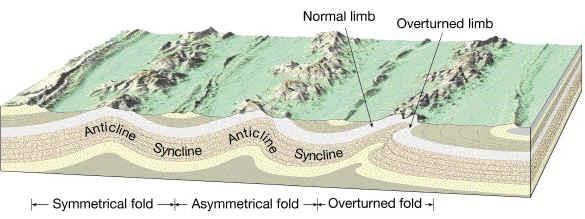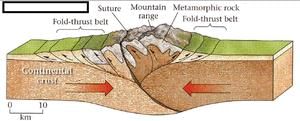UPSC Exam > UPSC Notes > Geography for UPSC CSE > Endogenic Forces
Endogenic Forces | Geography for UPSC CSE PDF Download
Endogenic forces: Epeirogenic and Orogenic
We have already seen that Geomorphic processes can create landforms. We also know that endogenic forces (internal) and exogenic forces (external) are the two main types of geomorphic processes. In this EduRev document, let’s study endogenic forces in detail.
- Geomorphic: relating to the form of the landscape and other natural features of the earth’s surface.
- The endogenic and exogenic forces causing physical and chemical changes on the earth’s surface are known as geomorphic processes.
- Diastrophism and volcanism are endogenic geomorphic processes. Weathering, mass wasting, erosion, and deposition are exogenic geomorphic processes.
- Geomorphic agent: mobile medium (like running water, moving ice masses, wind, waves, and currents etc.) which removes, transports and deposits earth materials.
Endogenic forces
- The interaction of matter and temperature generates these forces or movements inside the earth’s crust.
- The earth movements are mainly of two types: diastrophism and sudden movements.
- The energy emanating from within the earth is the main force behind endogenic geomorphic processes.
- This energy is mostly generated by radioactivity, rotational and tidal friction and primordial heat from the earth's origin. This energy due to geothermal gradients and heat flow from within induces diastrophism and volcanism in the lithosphere.
Diastrophism
- Diastrophism is the general term applied to slow bending, folding, warping and fracturing.
- Warp==make or become bent or twisted out of shape, make abnormal; distort.
- All processes that move elevate or build up portions of the earth’s crust come under diastrophism.
- They include:
- orogenic processes involving mountain building through severe folding and affecting long and narrow belts of the earth’s crust; In the orogeny process, the crust is severely deformed into folds.
- Epeirogenic processes involving uplift or warping of large parts of the earth’s crust;
- Due to epeirogeny, there may be simple deformation. Orogeny is a mountain building process whereas epeirogeny is a continental building process.
- Through the processes of orogeny, epeirogeny, earthquakes and plate tectonics, there can be faulting and fracturing of the crust. All these processes cause pressure, volume and temperature (PVT) changes, which induce metamorphism of rocks.

Question for Endogenic ForcesTry yourself:Which of the below mentioned is endogenetic process
View Solution
Epeirogenic or Continent forming movements [Vertical Movements]
- Epeirogenic movement refers to upheavals or depressions of land exhibiting long wavelengths [undulations] and little folding.
- The broad central parts of continents are called cratons and are subject to epeirogeny.
- Epeirogenic or continent forming movements act along the earth's radius; therefore, they are also called radial movements.
- Their direction may be towards (subsidence) or away (uplift) from the centre. The results of such movements may be clearly defined in the relief.
Uplift
- Raised beaches, elevated wave-cut terraces, sea caves and fossiliferous beds above sea level are evidences of uplift.
- Raised beaches, some of them elevated as much as 15 m to 30 m above the present sea level, occur at several places along the Kathiawar, Nellore, and Thirunelveli coasts.
- Several places which were on the sea some centuries ago are now a few miles inland.
- For example, Coringa near the Godavari's mouth, Kaveripattinam in the Kaveri delta and Korkai on the coast of Thirunelveli were all flourishing seaports about 1,000 to 2,000 years ago.
Subsidence
- Submerged forests and valleys, as well as buildings, are evidences of subsidence.
- In 1819, a part of the Rann of Kachchh was submerged as a result of an earthquake.
- The presence of peat and lignite beds below the sea level in Thirunelveli and the Sunderbans is an example of subsidence.
- The Andamans and Nicobars have been isolated from the Arakan coast by submergence of the
- intervening land.
- On the east side of Bombay island, trees have been found in the mud about 4 m below low watermark. A similar submerged forest has also been noticed on the Thirunelveli coast in Tamil Nadu.
- Many of the Gulf of Mannar and Palk Strait is very shallow and has been submerged in geologically recent times. A part of the former town of Mahabalipuram near Chennai (Madras) is submerged in the sea.
Orogenic or the mountain-forming movements [Horizontal Movements]
- Orogenic or the mountain-forming movements act tangentially to the earth’s surface, as in plate tectonics.
- Tensions produce fissures (since this type of force acts away from a point in two directions), and compression produces folds (because this type of force acts towards a point from two or more directions).
- In the landforms so produced, the structurally identifiable units are difficult to recognize.
- In general, diastrophic forces that have uplifted lands have predominated over forces that have lowered them.

Sudden Movements
- Sudden geomorphic movements occur mostly at the lithospheric plate margins (tectonic plate margins).
- The plate margins are volatile regions due to pressure created by magma pulling and pulling magma in the mantle (convectional currents).
- These movements cause considerable deformation over a short period.
Earthquakes
- It occurs when the surplus accumulated stress in rocks in the earth’s interior is relieved through the weak zones over the earth’s surface in the form of wave motion's kinetic energy causing vibrations (at times devastating) on the earth’s surface. Such movements may result in an uplift in coastal areas.
- An earthquake in Chile (1822) caused a one-meter uplift in coastal areas.
- Earthquakes may cause a change in contours, change in river courses, ‘tsunamis’ (seismic waves created in the sea by an earthquake, as they are called in Japan) which may cause shoreline changes, spectacular glacial surges (as in Alaska), landslides, soil creeps, mass wasting, etc.
Volcanoes
- Volcanism includes molten rock (magma) movement onto or toward the earth’s surface and the formation of many intrusive and extrusive volcanic forms.
- A volcano is formed when the molten magma in the earth’s interior escapes through the crust by vents and fissures in the crust, accompanied by steam, gases (hydrogen sulfide, sulfur dioxide, hydrogen chloride, carbon dioxide, etc.) and pyroclastic material. Depending on the chemical composition and viscosity of the lava, a volcano may take various forms.
- Pyroclastic => adjective of or denoting rock fragments or ash erupted by a volcano, especially as a hot, dense, destructive flow.
The document Endogenic Forces | Geography for UPSC CSE is a part of the UPSC Course Geography for UPSC CSE.
All you need of UPSC at this link: UPSC
|
269 videos|870 docs|231 tests
|
FAQs on Endogenic Forces - Geography for UPSC CSE
| 1. What are endogenic forces? |  |
Ans. Endogenic forces refer to the internal forces that shape the Earth's surface, including both epeirogenic and orogenic forces. These forces are generated within the Earth's interior and cause movements and deformations of the Earth's crust.
| 2. What is the difference between epeirogenic and orogenic forces? |  |
Ans. Epeirogenic forces are responsible for the gradual uplift or subsidence of large portions of the Earth's crust over long periods of time. They create broad, regional changes in the landscape, such as the formation of plateaus or basins. On the other hand, orogenic forces are responsible for the folding, faulting, and uplifting of the Earth's crust along plate boundaries, leading to the formation of mountains and mountain ranges.
| 3. How do endogenic forces contribute to landforms? |  |
Ans. Endogenic forces play a crucial role in shaping the Earth's landforms. Epeirogenic forces, through uplift or subsidence, create large-scale features like plateaus, rift valleys, and basins. Orogenic forces, on the other hand, result in the formation of mountains, fault lines, and folded structures. These forces continuously modify the Earth's surface over geologic time.
| 4. Can you give examples of landforms created by endogenic forces? |  |
Ans. Yes, examples of landforms created by endogenic forces include the Himalayas, which were formed by the collision of the Indian and Eurasian tectonic plates, the Great Rift Valley in Africa, which is the result of tectonic forces pulling apart the Earth's crust, and the Colorado Plateau in the United States, which was uplifted by epeirogenic forces.
| 5. How do endogenic forces impact human activities? |  |
Ans. Endogenic forces have significant implications for human activities. Orogenic forces can create valuable mineral resources in mountainous regions, such as gold, copper, and coal. However, they can also pose hazards such as earthquakes and volcanic eruptions. Epeirogenic forces influence the distribution of water resources, as they can cause the formation of basins or the uplift of areas with underground water sources. Understanding these forces is crucial for land-use planning and mitigating natural hazards.
Related Searches

















